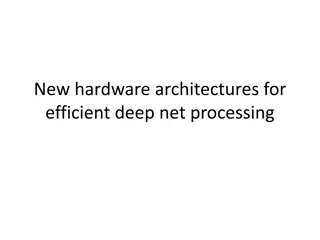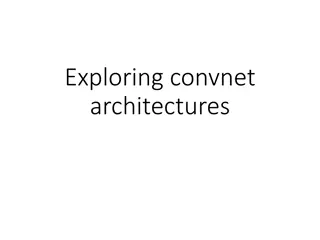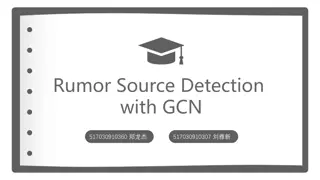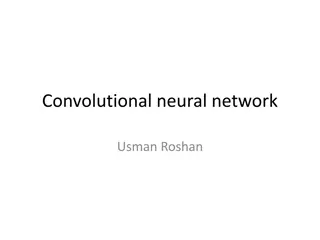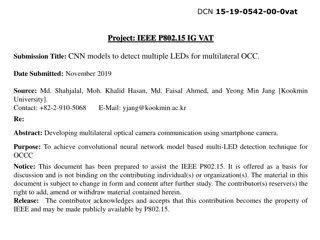Localised Adaptive Spatial-Temporal Graph Neural Network
This paper introduces the Localised Adaptive Spatial-Temporal Graph Neural Network model, focusing on the importance of spatial-temporal data modeling in graph structures. The challenges of balancing spatial and temporal dependencies for accurate inference are addressed, along with the use of distri
5 views • 19 slides
Exploring a Cutting-Edge Convolutional Neural Network for Speech Emotion Recognition
Human speech is a rich source of emotional indicators, making Speech Emotion Recognition (SER) vital for intelligent systems to understand emotions. SER involves extracting emotional states from speech and categorizing them. This process includes feature extraction and classification, utilizing tech
2 views • 15 slides
Network Slicing with OAI 5G CN Workshop Overview
Overview of Network Slicing with OAI 5G CN workshop focusing on the crucial role of network slicing in realizing the service-oriented 5G vision. This workshop covers topics like multiple logical networks creation on shared infrastructure, different types of network slices, preparation and instantiat
2 views • 6 slides
Convolutional Codes in Digital Communication
Convolutional codes provide an efficient alternative to linear block coding by grouping data into smaller blocks and encoding them into output bits. These codes are defined by parameters (n, k, L) and realized using a convolutional structure. Generators play a key role in determining the connections
0 views • 19 slides
Automated Melanoma Detection Using Convolutional Neural Network
Melanoma, a type of skin cancer, can be life-threatening if not diagnosed early. This study presented at the IEEE EMBC conference focuses on using a convolutional neural network for automated detection of melanoma lesions in clinical images. The importance of early detection is highlighted, as exper
0 views • 34 slides
Recent Developments on Super-Resolution: A Comprehensive Overview
Super-resolution technology aims to reconstruct high-resolution images from low-resolution inputs, with applications in video surveillance, medical diagnosis, and remote sensing. Various convolutional neural network (CNN) models have been developed, such as SRCNN, VDSR, ESPCN, and FSRCNN, each with
0 views • 12 slides
U-Net: A Convolutional Network for Image Segmentation
U-Net is a convolutional neural network designed for image segmentation. It consists of a contracting path to capture context and an expanding path for precise localization. By concatenating high-resolution feature maps, U-Net efficiently handles information loss and maintains spatial details. The a
1 views • 8 slides
EEG Conformer: Convolutional Transformer for EEG Decoding and Visualization
This study introduces the EEG Conformer, a Convolutional Transformer model designed for EEG decoding and visualization. The research presents a cutting-edge approach in neural systems and rehabilitation engineering, offering advancements in EEG analysis techniques. By combining convolutional neural
1 views • 6 slides
Convolutional Neural Networks: Architectural Characterizations for Accuracy Inference
This presentation by Duc Hoang from Rhodes College explores inferring the accuracy of Convolutional Neural Networks (CNNs) based on their architectural characterizations. The talk covers the MINERvA experiment, deep learning concepts including CNNs, and the significance of predicting CNN accuracy be
1 views • 21 slides
CNN-based Multi-task Learning for Crowd Counting: A Novel Approach
This paper presents a novel end-to-end cascaded network of Convolutional Neural Networks (CNNs) for crowd counting, incorporating high-level prior and density estimation. The proposed model addresses the challenge of non-uniform large variations in scale and appearance of objects in crowd analysis.
1 views • 17 slides
DRONET: Learning to Fly by Driving
DRONET presents a novel approach to safe and reliable outdoor navigation for Autonomous Underwater Vehicles (AUVs), addressing challenges such as obstacle avoidance and adherence to traffic laws. By utilizing a Residual Convolutional Neural Network (CNN) and a custom outdoor dataset, DRONET achieves
0 views • 20 slides
Wavelet-based Scaleograms and CNN for Anomaly Detection in Nuclear Reactors
This study utilizes wavelet-based scaleograms and a convolutional neural network (CNN) for anomaly detection in nuclear reactors. By analyzing neutron flux signals from in-core and ex-core sensors, the proposed methodology aims to identify perturbations such as fuel assembly vibrations, synchronized
3 views • 11 slides
Convolutional Neural Networks for Sentence Classification: A Deep Learning Approach
Deep learning models, originally designed for computer vision, have shown remarkable success in various Natural Language Processing (NLP) tasks. This paper presents a simple Convolutional Neural Network (CNN) architecture for sentence classification, utilizing word vectors from an unsupervised neura
1 views • 15 slides
Unified Features Learning for Buggy Source Code Localization
Bug localization is a crucial task in software maintenance. This paper introduces a novel approach using a convolutional neural network to learn unified features from bug reports in natural language and source code in programming language, capturing both lexicon and program structure semantics.
0 views • 18 slides
Deep Learning for Plant Disease Resistance Analysis
Utilizing deep learning facilitated microscopy, a research team led by Hening Cui from Columbia University aims to dissect durable resistance to plant diseases. The project focuses on segmenting hyphal networks of fungal and host plant cells using a deep convolutional neural network architecture cal
2 views • 13 slides
Efficient Hardware Architectures for Deep Neural Network Processing
Discover new hardware architectures designed for efficient deep neural network processing, including SCNN accelerators for compressed-sparse Convolutional Neural Networks. Learn about convolution operations, memory size versus access energy, dataflow decisions for reuse, and Planar Tiled-Input Stati
0 views • 23 slides
Unveiling Convolutional Neural Network Architectures
Delve into the evolution of Convolutional Neural Network (ConvNet) architectures, exploring the concept of "Deeper is better" through challenges, winner accuracies, and the progression from simpler to more complex designs like VGG patterns and residual connections. Discover the significance of layer
0 views • 22 slides
Convolutional Neural Networks (CNN) in Depth
CNN, a type of neural network, comprises convolutional, subsampling, and fully connected layers achieving state-of-the-art results in tasks like handwritten digit recognition. CNN is specialized for image input data but can be tricky to train with large-scale datasets due to the complexity of replic
0 views • 22 slides
Enhancing Network Stability with Network Monitoring Systems
Network monitoring is crucial for efficient management and proactive issue detection in a network environment. Factors influencing an effective network system include choosing the best OEM, SLA agreements, and selecting a reliable System Integrator. Reactive monitoring can lead to financial losses a
1 views • 12 slides
Monte Carlo Dropout for Uncertainty Analysis and ECG Trace Image Classification
In this paper, a Monte Carlo Dropout-based Convolutional Neural Network model is proposed for classifying ECG images to improve diagnosis accuracy and reduce uncertainty. The study aims to enhance the reliability of medical image analysis in the context of cardiovascular diseases through advanced de
0 views • 21 slides
Applications of CNNs in Skin Cancer Diagnosis
This study delves into the utilization of Convolutional Neural Networks (CNNs) for diagnosing skin cancer, particularly melanoma. It explores the challenges in distinguishing melanoma from benign and atypical conditions at a cellular level, emphasizing the importance of accurate mitosis detection. T
0 views • 21 slides
Network Slicing in 5GC
Network slicing in 5G Core (5GC) enables the creation of multiple virtual networks on a single physical infrastructure to cater to diverse requirements. The Non-Roaming 5G System Architecture outlines the reference points and functions involved in a 5G system. Service-Based Architecture (SBA) and Ne
0 views • 45 slides
Evaluation of IEEE 802.15.6ma Ultra-wideband Physical Layer
The evaluation of IEEE 802.15.6ma ultra-wideband physical layer utilizing super orthogonal convolutional codes for dependable wireless networks. Discussion on new standard IEEE802.15.6ma and the effectiveness of Super Orthogonal Convolutional Codes (SOCC) to improve dependability. Application and ev
0 views • 21 slides
Evaluation of IEEE 802.15.6ma Ultra-wideband Physical Layer
The performance of IEEE 802.15.6ma ultra-wideband physical layer utilizing Super Orthogonal Convolutional Codes is assessed for dependable wireless networks. Explore the application of Super Orthogonal Convolutional Codes in improving reliability in IEEE 802.15.6 UWB physical layer.
0 views • 17 slides
Convolutional Codes in Information Theory at University of Diyala
Concepts of convolutional codes and their application in error control coding within the Information Theory program at the University of Diyala's Communication Department. Understand the unique encoding process of convolutional encoders and the significance of parameters like coding rate and constra
0 views • 25 slides
Introduction to Convolutional Codes and Encoders
Convolutional codes are a type of error-correcting code that groups data digits into smaller blocks and encodes them with linear finite state shift registers. These codes are defined by generators and can be visualized using tree diagrams, state diagrams, and trellis diagrams. Learn about the struct
0 views • 12 slides
Rumor Source Detection with GCN: Unveiling the Propagation Mystery
In the realm of rumor detection, a groundbreaking approach using Graph Convolutional Networks (GCN) has emerged for source identification. This innovative method, known as LPSI, seeks to predict rumor sources based on network labels, challenging conventional content-based strategies. The iterative p
0 views • 16 slides
Integration of Telefonica CDN for Efficient Network Delivery
Telefonica is integrating its CDN with the transport network to enhance content delivery efficiency and network awareness. By making the CDN transport network aware, Telefonica aims to improve adaptability to network changes and provide real-time insights for optimal content delivery. The integratio
0 views • 6 slides
GPU Implementation of Convolutional Neural Networks: LeNet-5 and Parallelism
This text discusses the GPU implementation of Convolutional Neural Networks (CNN), focusing on LeNet-5 architecture for Hand-Written Digit Recognition. It covers topics such as the structure of CNN, the use of convolutional layers, and the forward path of a convolutional layer output. Additionally,
0 views • 45 slides
Encoding and Decoding of Convolutional Codes in Information Theory
In the realm of information and coding theory, Convolutional Codes serve as error-correcting codes essential for digital communication systems. This article delves into the encoding and decoding processes of Convolutional Codes, highlighting their significance in transmitting continuous data streams
0 views • 38 slides
Convolutional Neural Networks for Sentence Classification: Model Architecture & Regularization
Explore the application of Convolutional Neural Networks (CNNs) in sentence classification. Learn about the model architecture, data representation, convolution operations, max pooling, and regularization techniques like dropout. This paper presentation by Aradhya Chouhan delves into how CNNs have b
0 views • 15 slides
Understanding Convolutional Neural Networks for Image Classification
Discover the power of Convolutional Neural Networks (CNN) for image classification. Learn about convolutions, pooling, and training a CNN using techniques like backpropagation and dropout. Explore popular libraries like Keras, Pytorch, and TensorFlow for efficient CNN training on GPUs.
0 views • 6 slides
Understanding Convolutional Neural Networks (CNNs) for Image Processing
Learn about Convolutional Neural Networks (CNNs) and how they extract higher representations of images for better classification compared to traditional image processing methods. Explore the layers, architecture, and applications of CNNs in image classification, segmentation, and generation. Discove
0 views • 17 slides
Understanding Convolutional Neural Networks and Applications
Explore the fundamentals of Convolutional Neural Networks (CNNs), including their architecture, applications in computer vision, and the advantages of using convolution layers. Dive into topics such as image processing, feature detection, and the implementation of CNNs in various domains. Leverage t
0 views • 21 slides
Analysis of Sparse Convolutional Neural Networks & Deep Compression Techniques
Explore the impact of sparsity in convolutional neural networks, focusing on memory efficiency and performance improvements. Learn about deep compression pruning methods and the use of structured sparsity learning in neural networks. Discover the Caffe framework for building and running CNNs efficie
0 views • 20 slides
Advanced Object Detection Techniques for Optical Camera Communication
Explore the use of Convolutional Neural Network (CNN) models to detect multiple LEDs for multilateral Optical Camera Communication (OCC). Learn about computer vision tasks, DNN-based object detection techniques, and the implementation of Faster R-CNN, Mask R-CNN, YOLOv3, and SPP-net for accurate and
0 views • 9 slides
Progressive Encoding-Decoding Using Convolutional Autoencoder - Research Internship Insights
Explore the innovative research on image compression using neural networks, specifically Progressive Encoding-Decoding with a Convolutional Autoencoder. The approach involves a Deep CNN-based encoder and decoder to achieve different compression rates without retraining the entire network. Results sh
0 views • 7 slides
Understanding Convolutional Neural Networks for Image Classification
Dive into the world of Convolutional Neural Networks (CNNs) for image classification. Explore the concepts of convolutions, pooling, and CNN training techniques like backpropagation, dropout, and stochastic gradient descent. Learn how to optimize parameters and train CNNs efficiently using GPUs and
1 views • 6 slides
Neural Network Approach to Visual Tracking with FCN Model
Explore the use of Fully Convolutional Networks (FCN) in visual tracking, focusing on the FCN-tracker model and its benefits in object tracking with neural networks. Learn about the motivation, procedures, results, and conclusions of this innovative approach from the Chinese University of Hong Kong.
0 views • 22 slides
Achieving Fast and Robust ImageNet Classification with Deep CNNs
Explore the architecture, activation functions, GPU utilization, and conclusion of a deep convolutional neural network designed for ImageNet classification. Discover the importance of specific layers, ReLUs, GPUs, dataset size, and more in optimizing performance and accuracy.
0 views • 10 slides















